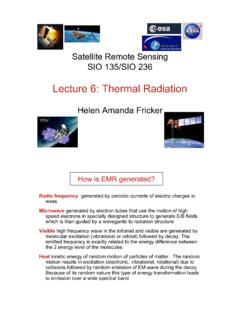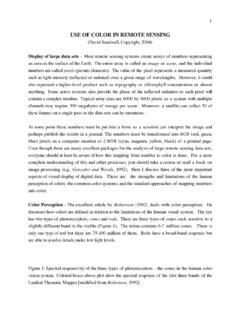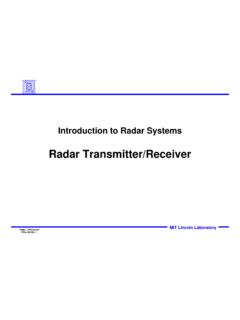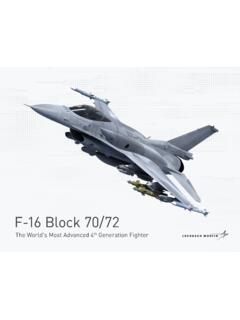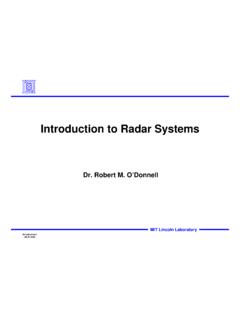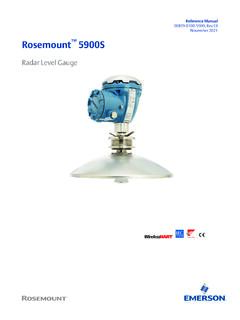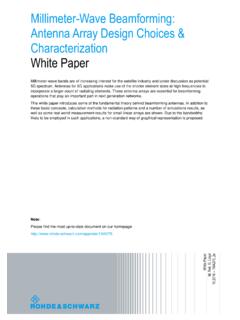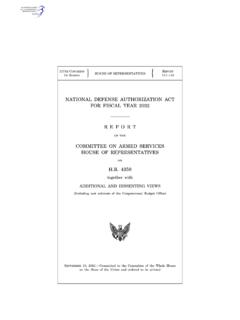Transcription of A Principles of Synthetic Aperture Radar
1 A Principles of Synthetic Aperture IntroductionSynthetic Aperture Radar (SAR) satellites collect swaths of side-looking echoes at a suf-ficiently high range resolution and along-track sampling rate to form high resolutionimagery (see Figure A1). As discussed in this appendix, the range resolution of theraw Radar data is determined by the pulse length (or 1/bandwidth) and theincidenceangle. For real Aperture Radar , the along-track orazimuthresolution of the outgoingmicrowave pulse is diffraction limited to an angle corresponding to the wavelength ofthe Radar ( m) divided by the length of the Aperture ( 10 m). When thisbeam pattern is projected onto the surface of the earth at a range of say 850 km, it illu-minates 4250 m in the along-track dimension so the raw Radar data are horribly out offocus in azimuth.
2 Using the Synthetic Aperture method, the image can be focused on apoint reflector on the ground by coherently summing thousands of consecutive echoesthus creating a Synthetic Aperture perhaps 4250 m long. Proper focus is achieved bysumming the complex numbers along a constant range. The focused image containsboth amplitude (backscatter) and phase (range) information for each AngleRadar PulsesSAR AntennaSub-satellite ground trackSatellite trajectoryFigure A1: Schematic diagram of a SAR satellite in orbit. The SAR antenna has itslong axis in the flight direction also called theazimuthdirection and the short axisin therangedirection. The Radar sends pulses to one side of theground trackthatilluminate the earth over a large elliptical footprint. The reflected energy returns to theradar where it is recorded as a function offast timein the range direction andslow time,or echo number, in the azimuth Fraunhoffer diffractionTo understand why a Synthetic Aperture is needed for microwave remote sensing fromorbital altitude one must understand the concepts of diffraction and resolution.
3 Con-sider the projection pattern of coherent radiation after it passes through an Aperture (see Figure A2). First we ll consider a 1-D Aperture and then go on to a 2-D rectangu-lar Aperture to simulate a rectangular SAR antenna. The 2-D case provides the shapeand dimension of the footprint of the Radar . Although we will develop the resolutioncharacteristics of apertures as transmitters of radiation, the resolution characteristicsare exactly the same when the Aperture is used to receive radiation. These notes weredeveloped from Rees 2001 and Bracewell sin AOscreen Aperture Figure A2: Diagram for the projection of coherent microwaves on a screen that is farfrom the Aperture of simulate coherent radiation by point sources of radiation distributed along theaperture between L/2 andL/2.
4 For simplicity we ll assume all the sources have thesame amplitude, wavelength , and phase. Given these sources of radiation, we solvefor the illumination pattern on the screen as a function of . We ll assume that thescreen is far enough from the Aperture so that raysAPandOPare parallel. Laterwe ll determine how far away the screen needs to be in order for this approximationto hold. Under these conditions, the rayAPis slightly shorter than the rayOPbyan amount ysin . This corresponds to a phase shift of 2 ysin . The amplitudeof the illumination at pointPis the integral over all of the sources along the aperture34 3 2 0 23 Figure A3: Sinc function illumination pattern for the Aperture shown in Figure by their complex phase valueP( )= L/2 L/2A(y)e i2 yksin dy(A1)wherek=1/.
5 This is called the Fraunhoffer diffraction integral. The illuminationacross the Aperture is uniform in both amplitude and phase so we setA(y)=1. Now lets=2 ksin so the fourier integral is easy to (s)= L/2 L/2e isydy=e isL/2 eisL/2 is=2ssin(sL/2)=Lsinc(sL/2)(A2)Replacings with 2 sin / we arrive at the final ( )=Lsinc(L sin )(A3)The illumination pattern on the screen is shown in Figure first zero crossing, or angular resolution rof the sinc function occurs whenthe argument is so sin r= Land for small angles r Land tan r sin that one could modify the screen illumination by changing the strength of theillumination across the Aperture . For example, a Gaussian Aperture would producea Gaussian illumination function on the screen. This would eliminate the sidelobesassociated with the sinc function but it would also broaden the projection pattern.
6 Inaddition, one could vary the phase along the Aperture to shift the point of maximumillumination away from =0. Such a phased array Aperture is used in some radarsystems to continuously illuminate a feature as the satellite passed over it. This iscalled spotlight mode SAR and it is a favorite technique for military can perform the same type of analysis with any 2-D Aperture ; many analyticexamples are given in Figure from Bracewell 1978. Below we ll be using a rectan-gular Aperture when we discuss Synthetic Aperture radars. For now, consider a uniformcircular Aperture has an angular resolution given by sin r= D D s r Figure A4: Beam-limited footprintDsof a circular Aperture ( Radar altimeter or opticaltelescope) at an altitude Geosat Radar altimeter orbits the Earth at an altitude of 800 km and illuminatesthe ocean surface with a 1-m parabolic dish antenna operating at Ku band ( GHz, = ) (Figure A4).
7 The diameter of the beam-limited footprint on the oceansurface isDs=2 Htan r Dor in this case 43 optical system with the same 1 m diameter Aperture , but operating at a wave-length of =5 10 7m, has a footprint diameter of m. The Hubble space tele-scope reports an angular resolution of arcsecond, which corresponds to an effectiveaperture of m. Thus a 1-m ground resolution is possible for optical systems whilethe same size Aperture operating in the microwave part of the spectrum has a 44,000times worse resolution. Achieving high angular resolution for a microwave system willrequire a major increase in the length of the moving on to the 2-D case, we should check the assumption used in devel-oping the Fraunhoffer diffraction integral that the raysAPandOPare parallel. Sup-pose we examine the case when =0; the ray pathAPis slightly longer thanOP(Figure A5).
8 This parallel-ray assumption breaks down when the phase of ray pathAPis more than /2 radians longer thanOPwhich corresponds to a distance of 4. Let sdetermine the conditions when this condition that the path length difference is smaller than 1/4 wavelength is[L24+z2]12 z< 4(A4)or can be rewritten as[(L2z)2+1]12 1< 4z(A5)Now assumeL zso we can expand the term in bracket in a binomial +L28z2 1< 4z(A6)36and we findzf>L22 wherezfis the Fresnel distance. So whenz<zfwe are in the nearfield and we need to use a more rigorous diffraction theory. However whenz zfweare safe to use the parallel-ray approximation and the Fraunhoffer diffraction integralis appropriate. Next consider some examples:Geosat:L=1 m, = mzf=23 mAt an orbital altitude of 800 km the parallel-ray approximation is telescope:L=1 m, =5 10 7mzf=4000 we see that an optical system with an orbital altitude of 800 km will require near-field about a Synthetic Aperture Radar (discussed below) such as ERS with a 4000 mlong Synthetic Aperture ?
9 ERS SAR:L=4000 m, = mzf=140,000 near-field optics are also required to achieve full SAR resolution for near-field correction is done in the SAR processor by performing a step calledrange migration and it is a large factor in making SAR processing so 2-D ApertureA 2-D rectangular Aperture is a good approximation to a typical spaceborne strip-modeSAR. The Aperture is longer in the flight direction (lengthL) than in the flight perpen-dicular direction (widthW) as shown in Figure A6. As in the 1-D case, one uses a 2-DFraunhoffer diffraction integral to calculate the projection pattern of the antenna. Theintegral isP( x, y)= L/2 L/2 W/2 W/2A(x,y) exp[i2 (xsin x+ysin y)]dxdy(A7)where is the wavelength of the Radar . As in the 1-D case we ll assume the apertureA(x,y) has uniform amplitude and phase.
10 In this case the projection pattern can bezL/2L24 + z21/2 OAPF igure A5: Diagram showing the increases length of path AP with respect to OP dueto an offset ysin xWL /L /WFigure A6: Diagram showing the projection pattern (right) for a rectangular SAR an-tenna (left).integrated analytically and isP( x, y)=LWsinc( Wsin x )sinc( Lsin y ).(A8)The first zero crossing of this 2-D sinc function is illustrated in Figure A6 (right).The ERS Radar has a wavelength of m, an antenna lengthLof 10 m, and anantenna widthWof 1 m. For a nominal look angle of 23 the slant rangeRis 850km. The footprint of the Radar has an along-track dimensionDa=2R /L, which is As discussed below this is approximately the length of the Synthetic Aperture usedin the SAR processor. The footprint in the range direction is 10 times larger or about85 Range resolution (end view)The Radar emits a short pulse that reflects offthe surface of the earth and returns to theantenna.
